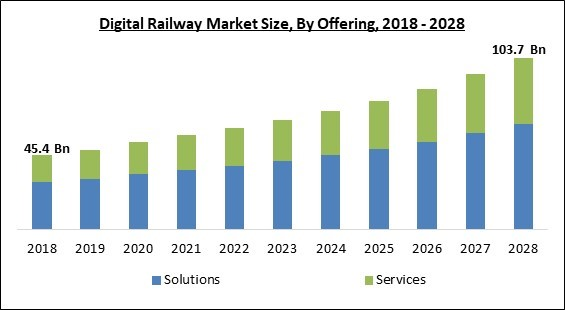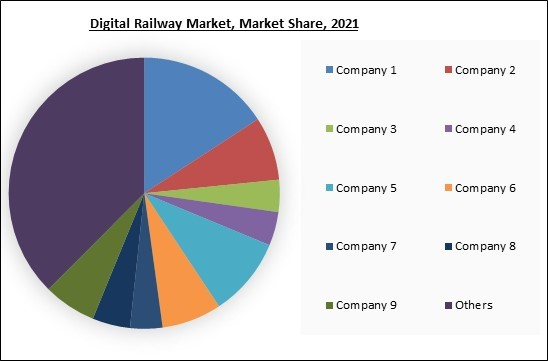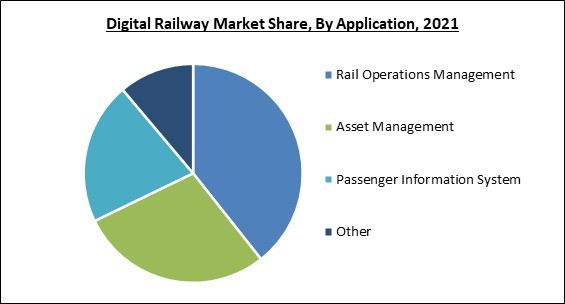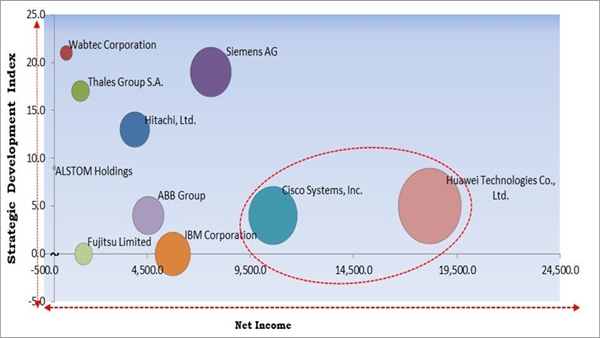The Global Digital Railway Market size is expected to reach $103.7 billion by 2028, rising at a market growth of 9.2% CAGR during the forecast period.
Providing a more dynamic, responsive, and functional railway for rail passengers in the digital era is the goal of the digital railway transformation. Humans Government is expected to be able to provide services more effectively and affordably than could with current technology due to digital train control. The railway will have the additional capacity as a result, and performance, safety, and sustainability will all increase.
The Secretary of State for Transportation and the CEO of Network Rail jointly launched the Digital Railway Strategy in 2018, which outlined the delivery strategy for digital installation across the network and identified and prioritized the projects with the strongest business cases. Train-fitting and infrastructure upgrades are coordinated by a long-term Digital Railway deployment plan.
This is expected to make it possible to transition to fully digital operation in the future with the least amount of expense, time, effort, and disruption to the railway's operations. The proposal considers the scope and difficulty of modifying more than 19,000 miles of rail and fitting out more than 4,000 trains for one of the largest and most intensively run rail networks in the world.
A railway of this scale and complexity cannot be swiftly constructed. To manage the switch to digital technology and preserve the continuity of services for passengers and cargo operators, a project this size will require a regular schedule of asset replacement. In the past, business models used by railroad organizations were primarily focused on engineering and operations.
The leading players in the market are competing with diverse innovative offerings to remain competitive in the market. The below illustration shows the percentage of revenue shared by some of the leading companies in the market. The leading players of the market are adopting various strategies in order to cater demand coming from the different industries. The key developmental strategies in the market are Acquisitions.
The major strategies followed by the market participants are Acquisitions. Based on the Analysis presented in the Cardinal matrix; Cisco Systems, Inc. and Huawei Technologies Co., Ltd. are the forerunners in the Digital Railway Market . Companies such as IBM Corporation, ABB Group and Huawei Technologies Co., Ltd. are some of the key innovators in Digital Railway Market .
The market research report covers the analysis of key stake holders of the market. Key companies profiled in the report include Siemens AG, ABB Group, Fujitsu Limited, IBM Corporation, Cisco Systems, Inc., ALSTOM Holdings, Huawei Technologies Co. Ltd., Thales Group S.A., Hitachi, Ltd., and Wabtec Corporation.
Providing a more dynamic, responsive, and functional railway for rail passengers in the digital era is the goal of the digital railway transformation. Humans Government is expected to be able to provide services more effectively and affordably than could with current technology due to digital train control. The railway will have the additional capacity as a result, and performance, safety, and sustainability will all increase.
The Secretary of State for Transportation and the CEO of Network Rail jointly launched the Digital Railway Strategy in 2018, which outlined the delivery strategy for digital installation across the network and identified and prioritized the projects with the strongest business cases. Train-fitting and infrastructure upgrades are coordinated by a long-term Digital Railway deployment plan.
This is expected to make it possible to transition to fully digital operation in the future with the least amount of expense, time, effort, and disruption to the railway's operations. The proposal considers the scope and difficulty of modifying more than 19,000 miles of rail and fitting out more than 4,000 trains for one of the largest and most intensively run rail networks in the world.
A railway of this scale and complexity cannot be swiftly constructed. To manage the switch to digital technology and preserve the continuity of services for passengers and cargo operators, a project this size will require a regular schedule of asset replacement. In the past, business models used by railroad organizations were primarily focused on engineering and operations.
The leading players in the market are competing with diverse innovative offerings to remain competitive in the market. The below illustration shows the percentage of revenue shared by some of the leading companies in the market. The leading players of the market are adopting various strategies in order to cater demand coming from the different industries. The key developmental strategies in the market are Acquisitions.
COVID-19 Impact Analysis
The government's ambition to digitally transform every industry drove market expansion. The businesses had enough time to introduce new technology slowly. IoT devices and modern technology were more widely accepted during the pandemic situation, which encouraged businesses to adopt modern technologies to meet customer demands and to simplify challenging processes, including ticket booking, freight management, and others, that aided in the market's expansion. The COVID-19 health crisis has a significant influence on all activities, and the containment measures that have been implemented as a result have had long-term negative financial and economic effects.Market Growth Factors
The Number Of Rail Passengers Has Increased In Recent Years
The number of passengers using trains has dramatically increased during the past few years in many different nations. Railway operators require a variety of digital railway solutions, such as traffic management tools, passenger information systems, and passenger analytics, to effectively manage the passenger traffic and deliver high-quality transportation services to an increasing number of passengers. These solutions improve client travel experiences while boosting the effectiveness of railroad operations.Demand For Cutting-Edge Transportation Infrastructure Is Increasing
All forms of railroad traffic are directly impacted by the effects of globalization. An increase in speed, security, and dependability is in demand. Therefore, regardless of the distance traveled or the anticipated number of steps needed to reach the destination, the next railway transportation ecosystem must provide solutions to satisfy the demand from source to destination with a high quality of service. People's needs are evolving continuously, necessitating the development of more accessible travel options.Market Restraining Factors
The Absence Of Robust Rail Infrastructure In Developing Nations
Some developing nations still don't have the resources to upgrade their train systems. Investment in rail infrastructure becomes more important than the digitization of the infrastructure for nations lacking robust train networks. Implementing cutting-edge digital technology requires a robust train infrastructure as well as a robust communication system. Only when used at a particular degree of scale are some digital technologies, like traffic management or passenger analytics, effective.Offering Outlook
By offering, the Digital Railway Market is bifurcated into Solution and Services. The solution segment acquired the highest revenue share in the Digital Railway Market in 2021. To maintain a good service level across their network, transportation companies are under pressure to strengthen and invest in their current infrastructure and resources as the number of rail trips increases year over year.Application Outlook
By Application, the Digital Railway Market is classified into Rail operations management, Passenger Information systems, Asset Management, and Other Applications. The passenger information system segment witnessed a substantial revenue share in the Digital Railway Market in 2021. An important channel of communication between transportation companies and passengers is provided by passenger information systems. The ability of operators to offer accurate and up-to-date knowledge on arrival and departure times is a crucial element of passenger pleasure, along with system dependability, safety, and general appearance.Regional Outlook
Region-wise, the Digital Railway Market is analyzed across North America, Europe, Asia Pacific, and LAMEA. The Asia Pacific region procured a promising revenue share in the Digital Railway Market in 2021. Due to the increased adoption of new technologies, more expenditures in digital transformation, and the development in GDP in the Asia Pacific countries, Asia Pacific is predicted to have the quickest rate of growth for the digital railway industry.Cardinal Matrix - Digital Railway Market Competition Analysis
The major strategies followed by the market participants are Acquisitions. Based on the Analysis presented in the Cardinal matrix; Cisco Systems, Inc. and Huawei Technologies Co., Ltd. are the forerunners in the Digital Railway Market . Companies such as IBM Corporation, ABB Group and Huawei Technologies Co., Ltd. are some of the key innovators in Digital Railway Market .
The market research report covers the analysis of key stake holders of the market. Key companies profiled in the report include Siemens AG, ABB Group, Fujitsu Limited, IBM Corporation, Cisco Systems, Inc., ALSTOM Holdings, Huawei Technologies Co. Ltd., Thales Group S.A., Hitachi, Ltd., and Wabtec Corporation.
Strategies deployed in Digital Railway Market
; Partnerships, Collaborations and Agreements:
- Aug-2022: ABB came into a partnership with Red Hat, an American software business. With this partnership, companies aimed to permit enterprises utilizing ABB’s process automation and industrial software to scale flexibly and rapidly utilize Red Hat’s dominating enterprise platforms and application services developed on Red Hat Enterprise Linux. Moreover, The partnership allows containerization and virtualization of automation software with Red Hat OpenShift to deliver developed flexibility in hardware deployment, optimized as per application requirements.
- May-2022: Wabtec Corporation joined hands with Deutsche Bahn, the second-largest transportation business in the world. Through this collaboration, the companies aimed to optimize the maintenance and operation of Wabtec equipment on council Deutsche Bahn trains. Additionally, the companies is expected to collaborate as a joint Steering Committee for various projects to improve the availability, reliability, and life cycle of Wabtec tools established on Deutsche Bahn trains.
- Apr-2022: Thales signed a Memorandum of Understanding with SMRT Trains, a rail operator in Singapore. With this agreement, the companies is expected to transfer engineering knowledge and rail expertise in diverse sectors and utilize digital technologies such as Artificial Intelligence and data analytics to release the full capabilities of the diagnostic data readily general within the current signalling and rail systems.
- Jan-2022: Hitachi Rail formed a partnership with Intermodal Telematics, a leader in the development of monitoring sensors and telematic solutions. Through this partnership, the companies aimed to adjoin IMT's pioneering monitoring sensors to Hitachi's living digital freight service. Additionally, The agreement is expected to permit Hitachi to deliver rail freight companies across the world a solution that delivers real-time monitoring to enhance safety and effectiveness.
- Sep-2021: Alstom came into a partnership with Airbus CyberSecurity, a European specialist in cyber security. Through this partnership, the companies aimed to deliver rail operators with services and solutions integrating Alstom’s solutions and expertise in rail transport within Airbus CyberSecurity’s expertise and services in providing the security of industrial information systems.
- Sep-2020: Siemens AG signed an agreement with Atos, an international leader in digital transformation. This agreement aimed to boost Siemens’ digital objectives in the field of services digitalization and modernization, cloud transformation, data-driven digital, and cybersecurity. Additionally, Atos is expected to also support innovation and digital modernization, to reach crucial innovation issues for Siemens.
- Jan-2020: Thales formed a partnership with Confidex, a supreme designer and supplier of short-range wireless identification solutions. Together, the companies aimed to introduce a Flexible Clap Card for MassTransit Market. Additionally, Thales and Confidex are delivering a reloadable product to support lower cost and trash linked with the more than 550 million magnetic tickets published each year.
; Product Launches and Product Expansions:
- Jun-2022: Wabtec introduced Precision Dispatch System. The new Wabtec Precision Dispatch System is developed to move trains safely and effectively around the rail network in both signalled and dark territory, as well as deliver complete transparency of network requirements and monitor all devices in the network. Additionally, Precision Dispatch analyzes data collected from all rolling stock and Positive Train Control and wayside device assets.
- May-2022: Hitachi Rail launched PTC onboard system and digital railcar telematics. The new Positive Train Control is an onboard system is an Interoperable Train Control solution for cargo railroads and commuter rail operators.
- May-2022: Thales introduced the launch of its prevailing Train Protection and Warning System (TPWS) Mk4 Single Cab Control Unit. The new TPWS Mk4 is comfortable to fit and run with current systems in both dual and single cabs, with no requirement to change anything under the vehicle, TPWS Mk4 is a concise, cost-effective advancement that demands minimal staff training, whilst providing interoperability with European Train Control System.
- Feb-2022: Thales introduced Robust Train Positioning System, a system that delivers precise train positioning data and a digital map. The new Robust Train Positioning System focused on increasing safety by utilizing a mixture of sensors that gather crucial data on train positioning, which is integrated with a digital map of the track, supplying precise and constant positioning results for train drivers and other attendants.
- Dec-2021: Siemens along with VGF unveiled Digital Train Control System. The new train control system is intended to substitute the traditional train control system used in metro and tram networks. Additionally, This system is designed to improve the efficiency and ability of train routes, particularly in the underground passages.
- Oct-2021: Siemens Mobility came into a partnership with Deutsche Bahn, the second-largest transport company in the world. Through this partnership, the companies aimed to design the world’s first automated train, which is completely controlled and automated by digital technology and requires no human interference.
- Mar-2021: Siemens Mobility introduced MoComp, a compact and single source display, and make known to all consumers the diverse Siemens Mobility offering of rail vehicle components. The new MoComp is expected to deliver an entire range of mechanical and electrical components and system solutions for modern rail vehicles. Moreover, it contains propulsion systems, pantographs, brakes, bogies, and onboard power supplies.
- Mar-2021: Thales unveiled SelTracTM G8, the 8th generation, Communications Based Train Control system. The new SelTrac G8 system possesses evolution and flexibility abilities, depending on the latest technologies to extremely decrease building and lifecycle price, while preserving passenger safety. Additionally, unique elements contain a new digital architecture, with improved services and sovereignty abilities.
; Acquisitions and Mergers:
- Jun-2022: Wabtec Corporation completed the acquisition of Collins Aerospace’s ARINC rail solutions, a supplier of intelligence-based rail dispatch and back office solutions. Through this acquisition, ARINC’s rail solutions systems, associated with Wabtec’s digital and electronics offering, is expected to boost the industry’s travel of rail optimization.
- Apr-2022: Wabtec Corporation completed the acquisition of Trimble’s Beena Vision business, a producer of machine vision-based wayside inspection systems. This acquisition is expected to expand Wabtec’s unparalleled digital and electronics offering, improving its capability to advance wayside train condition monitoring, along with supply chain and logistics technology for railroad consumers across the world.
- Jan-2022: Wabtec Corporation took over Masu, the railway friction industry. This acquisition is expected to reinforce its established base, as well as develop its brake product offering. Additionally, Wabtec is expected to also be capable to toughen its position as a foremost rail manufacturer in India
- Oct-2021: Siemens Mobility completed the acquisition of qills, a creative full-service developer of software solutions. Through this acquisition, Siemens is expected to deliver operators with a complete SaaS offering that optimizes their essential travel processes, such as reservation, trip searching, ticketing management, and inventory.
- Aug-2021: Hitachi Rail completed the acquisition of Thales’ Ground Transportation Systems business, a French multinational company. With this acquisition, Hitachi Rail desires to propel growth by extending the scale of its rail signaling systems industry globally, obtaining an improved turnkey railway portfolio to new markets across the world. Furthermore, The integrated strength of Hitachi and GTS’s Digital expertise is expected to also help Hitachi Rail to boost its Mobility as a Service offering for an international consumer base.
- May-2021: Siemens Mobility took over RailTerm, a Canada-based provider of rail assistance to railroads and transit agencies. With this partnership, Siemens aimed to promote the deployment of the next era of rail technologies throughout Canada’s railway networks. Moreover, this acquisition is expected to result in the development of Siemens Mobility’s current Canadian offering.
- Apr-2021: Hitachi Rail acquired Perpetuum, a UK-based rail technology firm. Through this acquisition, the technology firm is expected to now work on optimizing, improving, and developing the application of the technology in Hitachi’s international transportation offering. Additionally, by noticing onboard vibrations, Perpetuum’s self-powering sensors deliver real-time information about the performance of vital train components, allowing timely substitutes.
- Mar-2021: Wabtec Corporation completed the acquisition of Nordco, an American manufacturer of railroad maintenance. With this acquisition, Wabtec is expected to raise its established base and propel the growth across Nordco’s innovative product offering both internationally and domestically.
- Jul-2020: Cisco completed the acquisition of Fluidmesh Networks, a leader in wireless backhaul systems. Through this acquisition, the companies aimed to integrate Cisco’s scale within Fluidmesh’s solution-based portfolio and relationships with systems integrators, which is expected to boost Cisco’s industrial IoT enterprise to help successful industrial wireless deployments, and widen its reach to key consumer partners, segments, and end users.
Scope of the Study
Market Segments Covered in the Report:
By Offering
- Solutions
- Remote Monitoring
- Network Management
- Route Optimization And Scheduling
- Predictive Maintenance
- Analytics
- Security
- Others
- Services
- Professional Services
- Managed Services
By Application
- Rail Operations Management
- Asset Management
- Passenger Information System
- Other
By Geography
- North America
- US
- Canada
- Mexico
- Rest of North America
- Europe
- Germany
- UK
- France
- Russia
- Spain
- Italy
- Rest of Europe
- Asia Pacific
- China
- Japan
- India
- South Korea
- Singapore
- Malaysia
- Rest of Asia Pacific
- LAMEA
- Brazil
- Argentina
- UAE
- Saudi Arabia
- South Africa
- Nigeria
- Rest of LAMEA
Key Market Players
List of Companies Profiled in the Report:
- Siemens AG
- ABB Group
- Fujitsu Limited
- IBM Corporation
- Cisco Systems, Inc.
- ALSTOM Holdings
- Huawei Technologies Co. Ltd.
- Thales Group S.A.
- Hitachi, Ltd.
- Wabtec Corporation
Unique Offerings from the Publisher
- Exhaustive coverage
- The highest number of Market tables and figures
- Subscription-based model available
- Guaranteed best price
- Assured post sales research support with 10% customization free
Table of Contents
Chapter 1. Market Scope & Methodology
Chapter 2. Market Overview
Chapter 3. Competition Analysis - Global
Chapter 4. Global Digital Railway Market by Offering
Chapter 5. Global Digital Railway Market by Application
Chapter 6. Global Digital Railway Market by Region
Chapter 7. Company Profiles
Companies Mentioned
- Siemens AG
- ABB Group
- Fujitsu Limited
- IBM Corporation
- Cisco Systems, Inc.
- ALSTOM Holdings
- Huawei Technologies Co. Ltd.
- Thales Group S.A.
- Hitachi, Ltd.
- Wabtec Corporation
Methodology

LOADING...












